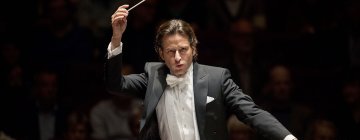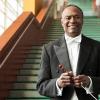Conductor Gustavo Dudamel returned to the Hollywood Bowl — the place where his skyrocketing North American career was launched 20 years ago — on Aug. 5, and the greeting was deafening. The 103-year-old amphitheater was packed; I guesstimated the attendance at about 15,000, a huge total for a classical Tuesday night. One attendee told me that the crowd was so big that they ran out of printed programs.
It’s possible that many were there to hear music by Duke Ellington or were drawn to the event by star South Korean pianist Seong-Jin Cho playing both of Maurice Ravel’s piano concertos. But Gustavo was the main attraction, perhaps because of the possibility that the week’s concerts may be his last at the Bowl as music and artistic director of the Los Angeles Philharmonic. He should have had two weeks left in his tenure, but when the Simón Bolívar Symphony Orchestra of Venezuela was forced to cancel its Bowl appearances scheduled for Aug. 12-16 due to “travel complications,” Dudamel pulled out, too, as did his featured soloist Yuja Wang.
Now for the good news. Dudamel should be a natural for Ellingtonia, given his strong feeling for rhythm across the board, yet it has taken him some time to get complete control over the idiom. He’s got it now, as his madly swinging performance of Harlem (alternately titled A Tone Parallel to Harlem) in Maurice Peress’s orchestration would have raised the roof over the Bowl if it had a roof.
Dudamel brought a raw raucousness to the textures and a sauntering, swampy feeling to the big tune in the center. The imported sax section was slurpy and bluesy — one of their riffs lifted me out of my chair — the trumpeters and trombonists manipulated their plunger mutes like jazz masters, and the unidentified trap drummer had that Sam Woodyard groove down. The Afro-Cuban finale cooked.
The other Ellington piece on the program was more problematic. Written for the Ellington band’s Carnegie Hall debut in 1943, Black, Brown and Beige’s original length was about 50 minutes, but in response to criticism, the pragmatic bandleader cut it down to a half hour the following year and even more for the band’s subsequent recording and further revisions.
Peress’s 18-minute-long version seems to have become the standard text for symphony orchestras, but to my mind it is not representative of the best ideas this score has to offer. Peress consulted the composer when assembling and orchestrating his suite, yet there is so much gold that he left out — the flamboyant “West Indian Dance,” “The Blues,” or Billy Strayhorn’s urbane “Sugar Hill Penthouse,” for example — and despite the pruning and frequent reappearances of “Come Sunday” and “Work Song,” it still felt episodic. Nevertheless, Dudamel approached the suite with the same mastery he displayed in Harlem, with much success.
Sandwiched in between the Ellington swingfests were Ravel’s Piano Concerto for the Left Hand and Piano Concerto in G, both of which display jazz influences — the latter far more than the former — that make them quite compatible with Ellington on a program. Ellington once told classical music critic Alfred Frankenstein that he wanted to write a concert piece that started “from the inside” of Black America, whereas Ravel was clearly coming to his from the outside.
Inside or out, Cho glommed onto the big chords of the Left Hand Concerto with gusto, and Dudamel enforced textures that were thick, ardent, and loudly projected over the sound system. Cho danced through the toccata-like passages of the Concerto with heavy accents in the first movement and more characterful touches in the finale as Gustavo procured saucy comments from the wind and brass soloists. There were no encores despite the crowd’s wishes; Cho had done more than enough for one night.




